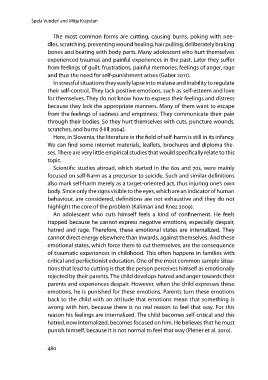Page 480 - Štemberger Tina, Čotar Konrad Sonja, Rutar Sonja, Žakelj Amalija. Ur. 2022. Oblikovanje inovativnih učnih okolij. Koper: Založba Univerze na Primorskem
P. 480
ela Vunderl and Mitja Krajnčan
The most common forms are cutting, causing burns, poking with nee-
dles, scratching, preventing wound healing, hair pulling, deliberately braking
bones and beating with body parts. Many adolescent who hurt themselves
experienced traumas and painful experiences in the past. Later they suffer
from feelings of guilt, frustrations, painful memories, feelings of anger, rage
and thus the need for self-punishment arises (Gaber 2011).
In stressful situations they easily lapse into malaise and inability to regulate
their self-control. They lack positive emotions, such as self-esteem and love
for themselves. They do not know how to express their feelings and distress
because they lack the appropriate manners. Many of them want to escape
from the feelings of sadness and emptiness. They communicate their pain
through their bodies. So they hurt themselves with cuts, puncture wounds,
scratches, and burns (Hill 2004).
Here, in Slovenia, the literature in the field of self-harm is still in its infancy.
We can find some internet materials, leaflets, brochures and diploma the-
ses. There are very little empirical studies that would specifically relate to this
topic.
Scientific studies abroad, which started in the 60s and 70s, were mainly
focused on self-harm as a precursor to suicide. Such and similar definitions
also mark self-harm merely as a target-oriented act, thus injuring one’s own
body. Since only the signs visible to the eyes, which are an indicator of human
behaviour, are considered, definitions are not exhaustive and they do not
highlight the core of the problem (Kaliman and Knez 2009).
An adolescent who cuts himself feels a kind of confinement. He feels
trapped because he cannot express negative emotions, especially despair,
hatred and rage. Therefore, these emotional states are internalized. They
cannot direct energy elsewhere than inwards, against themselves. And these
emotional states, which force them to cut themselves, are the consequence
of traumatic experiences in childhood. This often happens in families with
critical and perfectionist education. One of the most common sample situa-
tions that lead to cutting is that the person perceives himself as emotionally
rejected by their parents. The child develops hatred and anger towards their
parents and experiences despair. However, when the child expresses these
emotions, he is punished for these emotions. Parents turn these emotions
back to the child with an attitude that emotions mean that something is
wrong with him, because there is no real reason to feel that way. For this
reason his feelings are internalized. The child becomes self-critical and this
hatred, now internalized, becomes focused on him. He believes that he must
punish himself, because it is not normal to feel that way (Plener et al. 2010).
480
The most common forms are cutting, causing burns, poking with nee-
dles, scratching, preventing wound healing, hair pulling, deliberately braking
bones and beating with body parts. Many adolescent who hurt themselves
experienced traumas and painful experiences in the past. Later they suffer
from feelings of guilt, frustrations, painful memories, feelings of anger, rage
and thus the need for self-punishment arises (Gaber 2011).
In stressful situations they easily lapse into malaise and inability to regulate
their self-control. They lack positive emotions, such as self-esteem and love
for themselves. They do not know how to express their feelings and distress
because they lack the appropriate manners. Many of them want to escape
from the feelings of sadness and emptiness. They communicate their pain
through their bodies. So they hurt themselves with cuts, puncture wounds,
scratches, and burns (Hill 2004).
Here, in Slovenia, the literature in the field of self-harm is still in its infancy.
We can find some internet materials, leaflets, brochures and diploma the-
ses. There are very little empirical studies that would specifically relate to this
topic.
Scientific studies abroad, which started in the 60s and 70s, were mainly
focused on self-harm as a precursor to suicide. Such and similar definitions
also mark self-harm merely as a target-oriented act, thus injuring one’s own
body. Since only the signs visible to the eyes, which are an indicator of human
behaviour, are considered, definitions are not exhaustive and they do not
highlight the core of the problem (Kaliman and Knez 2009).
An adolescent who cuts himself feels a kind of confinement. He feels
trapped because he cannot express negative emotions, especially despair,
hatred and rage. Therefore, these emotional states are internalized. They
cannot direct energy elsewhere than inwards, against themselves. And these
emotional states, which force them to cut themselves, are the consequence
of traumatic experiences in childhood. This often happens in families with
critical and perfectionist education. One of the most common sample situa-
tions that lead to cutting is that the person perceives himself as emotionally
rejected by their parents. The child develops hatred and anger towards their
parents and experiences despair. However, when the child expresses these
emotions, he is punished for these emotions. Parents turn these emotions
back to the child with an attitude that emotions mean that something is
wrong with him, because there is no real reason to feel that way. For this
reason his feelings are internalized. The child becomes self-critical and this
hatred, now internalized, becomes focused on him. He believes that he must
punish himself, because it is not normal to feel that way (Plener et al. 2010).
480


